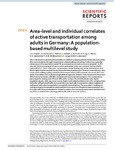Area-level and individual correlates of active transportation among adults in Germany: A population-based multilevel study
Finger, Jonas D.
Varnaccia, Gianni
Gabrys, Lars
Hoebel, Jens
Kroll, Lars E.
Krug, Susanne
Manz, Kristin
Baumeister, Sebastian E.
Mensink, Gert B. M.
Lange, Cornelia
Leitzmann, Michael F.
This study aimed at estimating the prevalence in adults of complying with the aerobic physical activity (PA) recommendation through transportation-related walking and cycling. Furthermore, potential determinants of transportation-related PA recommendation compliance were investigated. 10,872 men and 13,144 women aged 18 years or older participated in the cross-sectional ‘German Health Update 2014/15 – EHIS’ in Germany. Transportation-related walking and cycling were assessed using the European Health Interview Survey-Physical Activity Questionnaire. Three outcome indicators were constructed: walking, cycling, and total active transportation (≥600 metabolic equivalent, MET-min/week). Associations were analyzed using multilevel regression analysis. Forty-two percent of men and 39% of women achieved ≥600 MET-min/week with total active transportation. The corresponding percentages for walking were 27% and 28% and for cycling 17% and 13%, respectively. Higher population density, older age, lower income, higher work-related and leisure-time PA, not being obese, and better self-perceived health were positively associated with transportation-related walking and cycling and total active transportation among both men and women. The promotion of walking and cycling among inactive people has great potential to increase PA in the general adult population and to comply with PA recommendations. Several correlates of active transportation were identified which should be considered when planning public health policies and interventions.

